- Introduction
- The Concept of Diversity in the Workplace
- Benefits of Workplace Diversity in the Organizations
- Challenges of Diversity in the Workplace
- Successful Management of Diversity in the Workplace
- Assessment of Diversity in the Workplace
- Development and Promotions of Diversity in the Workplace Plan
- Actualization
- Recommendations
- Conclusion
- Reference List
Introduction
It is notable that in the changing trend of the corporate world, globalization embraces business organizations from all spheres, which increase the need for the multinational corporations to employ people from local or ethnic backgrounds. In addition, rising numbers of trained, educated, proficient, and competent populations at rural communities indicate the necessity for such organizations to offer job opportunities to skilled forces. As a result, diversity is created within the workforce, which in turn increases the chances of discrimination, partiality, unfairness, and racially aggravated harassment at workplace.
Thus, this paper focuses on assessing the concept of diversity in the workplace from different social, corporate, and cultural perspectives; in order to attain this purpose, it is highly essential to understand and define the concept of diversity in the workplace from practical viewpoints, and assess the key perception regarding workplace diversity. In addition, it is extremely important to discuss and evaluate the benefits of workplace diversity within the organizations, and the way in which the businesses are trying to extract the highest possible returns out of it.
This paper also deals with reviewing the possible and latent challenges of diversity in the workplace, along with discussing the successful management of diversity in the workplace, and assessing workplace diversity from an overall viewpoint. In addition, the research scrutinizes the development and promotions of diversity in the workplace plan, actualization (for example, actions to promote diversity at workplace), followed by apt recommendations in accordance with contemporary corporate issues, as well as an apposite conclusion.
The Concept of Diversity in the Workplace
According to Bell (2011), the concept of diversity in workplace concentrates on the variations and resemblances brought by individual workers and employers into a business; it refers to magnitudes ahead of those stated officially on equal opportunity and anti discriminatory regulations; in addition, diversity is frequently clarified to comprise magnitudes that persuade characteristics and perceptions brought about by individuals.
However, Tisserant, Wagner, and Barth (2013) noted that diversity is a comprehensive concept to include everybody irrespective of their backgrounds by harmonizing anti discriminatory conformity agendas through generating workplace atmosphere and group customs; it refers to knowing to respect people who are from different backgrounds and practicing to promote multi-cultural engagement by varied lookouts because every individual is inimitable.
Although individuals possess familiar features between themselves, they may be, in most cases, diverse in major aspects; however, divergence may comprise noticeable or non-noticeable traits, such as private distinctiveness, like background, traditions, character, working approaches, religion, tone of voice, language, etc; many such atypical private features are guarded by anti discriminatory regulations for assisting workers from being controlled unjustly.
Furthermore, it is important to note that particularly in western countries, the guarded features may consist of ethnicity, physical and mental ability, race, sex relocation, class, gay rights, matrimonial issues, civil-partnership, pregnancy or parenthood, spiritual practice or faith, personal orientation, conventions, odd customs, color, or even age; however, only working together without considering the race could bring success in performance.
Workplace diversity is normally described as admitting, appreciating, accommodating, signifying, and observing dissimilarities amid workforce; these concerns convey much significance today, as researchers expect this to turn further essential in upcoming years for rising diversities in workforces around the globe; moreover, businesses are trying to be entirely comprehensive in terms of diversity as it can give better outputs and benefits.
On the other hand, organizing and appreciating workplace diversity is crucial constituent for efficient HR administration for ultimate progress in workplace output; further, alterations like female at work, managerial reforms, in addition to equal-opportunity laws would make businesses to reassess administrative performances to extend fresh methods to supervise HR; considering all these factors, in current situation, handling diversity is vital. Alcazar, Fernandez, and Gardey (2013) noted that today, the rapid pace of globalization needs additional communication amid natives of varied civilizations, values, or ethnicity because individuals, in present condition, do not survive or do business at inward-looking industry; rather, they deal with an international market with high antagonism; so, businesses must turn more assorted into correspondingly resourceful and receptive bodies.
Enlarging or exploiting workplace diversity is now a noteworthy subject for business dealings; however, as dealing with diversity stays a momentous directorial problem, employers should cope with the supervisory abilities desirable on a multi-cultural workplace; Barak (2010) stated that employers should edify everyone in the group to appreciate multi-cultural disparities in workplace to care for individuals with respect.
In most cases, necessity of recognizing workplace diversity became essential for female participation at work, as present labor forces possess maximum number of female workers; additionally, the amount of double income-families and sole-working mothers augmented too; however, Kanter (1977) noted that alteration of family arrangement indicates fewer men and women in the usual family-roles; consequently, assortment diminishes various ethnicity concerns.
On the other hand, Barak (2010) stated that noteworthy transformations at businesses because of economizing, off shoring, and outsourcing has deeply influenced HR supervision; in addition, workplace performances also distorted because of globalization and technical innovations in IT-sector, which in turn has extended the working time of people; however, in another sense, reshuffling typically made lesser people performing additional works.
Kanter (1977) pointed out that communities throughout the globe are dissimilar in terms of culture and customs; moreover, for rising migration rates, rising figure of inhabitants operating overseas, and occurrence of aboriginal tribal groups, diverse-workers are now looking ahead to work in multinational corporations; separate workforces show exclusive customs and living standards, and as a result, MNCs are more diverse.
Therefore, the upcoming HR would comprise a higher engagement of female, minorities, aged-people, and handicaps; however, whether all these changes would bring effectual and competent administration would depend on the marketplace and financial condition of companies; however, there is no doubt that only businesses that would acknowledge globalization of labor optimistically and assist such people would become successful in long-run.
Benefits of Workplace Diversity in the Organizations
Kundu (2003) identified that efficient businesses seek workers with dissimilar skills than ordinary or regular workers as miscellaneous employees could mean special aptitudes or ideologies; so, businesses that fall short to respond to cultural-diversity efficiently or discourage accepting optimistic view for removing prejudice could unfavorably influence workers and patrons; businesses must reorganize visions, policies, and management-practices for satisfying miscellaneous workers. Kundu (2003) also added that linking diversity with the workplace would be the main way of generating, expanding, and sustaining a unified business; in addition, Skaggs and DiTomaso (2004) pointed out that for the sake of apt administration, it is highly essential to distinguish dissimilarities and cope to exploit this for corporate benefit, instead of avoiding or undermining this.
On the other hand, Hayles and Russell (1997) further expressed that due to numerous reasons, executives, shareholders, decision-makers, and other stakeholders must be trained to admire the diversity in workplace and work together for capitalizing the input of every worker without focusing on whether they are from a totally different cultural, religious, national, ethnic, or social context.
Diversity is advantageous for almost every stakeholder in the business; even though collaborators are inter-reliant at workplace, admiring personal dissimilarities could raise output (Meyers, 2006; Jackson, 1993; UNAC & UNGCO 2009; Hayles and Russell, 1997; and Kundu, 2003; and Skaggs & DiTomaso (2004). At the same time, it could lower proceedings and boost promotional prospects, enrollment, inventiveness, efficiency, and goodwill while flexibility is vital for competitive advantage, diversity is decisive for success; moreover, loss of time and money occurs for proceedings on discrimination (Meyers, 2006; Jackson, 1993; UNAC & UNGCO 2009; Hayles and Russell, 1997; and Kundu, 2003; and Skaggs & DiTomaso (2004).
On the other hand, Skaggs and DiTomaso (2004) noted that in terms of not only profitability or public image of the firm, workplace assortment has huge significance over employment outcomes; some researchers suggest how various devices and key issues of a non-diversified workplace can adversely affect the employment factors. It is important to state that different researchers, such as Meyers (2006), Jackson (1993), and Kundu (2003) discussed and assessed a number of ways in which workplace diversity in organizations can help the business to become successful in long-run; as a result, a brief outline of the key benefits together with the assessment of their pragmatic applications are given below-
Table 1: Assessing the benefits of diversity in organizations
Challenges of Diversity in the Workplace
Hayles and Russell (1997) suggests that a great number of challenges exist that often hinder the creation of diversity in workplace; in fact, it is often more difficult to direct, sustain or handle it in long-run rather than just getting involved in the recruitment process of the minorities in first instance. They further added that the recruiters, decision-makers, managerial panel, or even shareholders or directors must first appreciate the fact that dealing with a diverse workforce is, by a huge number of ways, different form merely admitting dissimilarities amongst the entire labor force, and in many ways, it is greatly difficult as well.
It is highly vital to state that the recruiters, decision-makers, managers, and colleagues more often find it too tough to be engaged in respecting people from diverse races, fighting against unfairness, or even encouraging and promoting comprehensiveness; as a result, it seems quite clear that it is far easier to perform the tasks rather than just to say it. In addition, apart from internal challenges, a number of external challenges exist in the social culture that often hampers a firm with a diverse workforce; the figure below shows the barriers in a snapshot in more details-
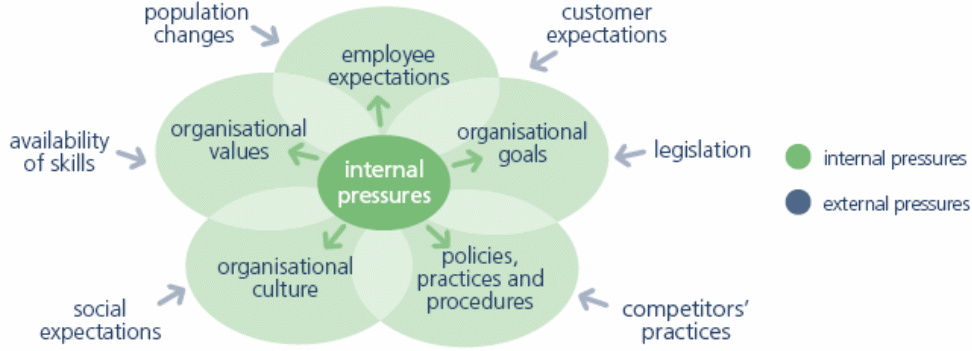
The employers’ working progresses, or the firm’s productivity, outcomes, performance, and profits are often hampered while ensuring diversity in workplace due to a number of factors; for example, Barak (2010) notes that ensuring diversity usually leads to some colleagues or workers failing to cope up with different cultures and races, eventually resulting in staff turnover and loss of production. It may also result in wastage of money in training, in addition to higher costs incurred for unfairness, bias, grievances, and the consequent lawful steps taken against the firm for proving such allegations; however, it is notable that the court proceedings are on the whole costly and failing to disprove the allegations may result in higher penalties imposed.
On the other hand, another huge difficulty that businesses seeking to ensure diversity in workplace may face is the threat of negative way of thinking among the co-workers and ill conducts that are practiced with people of different racial backgrounds; there is no doubt that such practices is capable of injuring working relations and spoiling self-esteem and overall efficiency. The figure below shows the key challenges that a business may face while implementing diversity agendas-
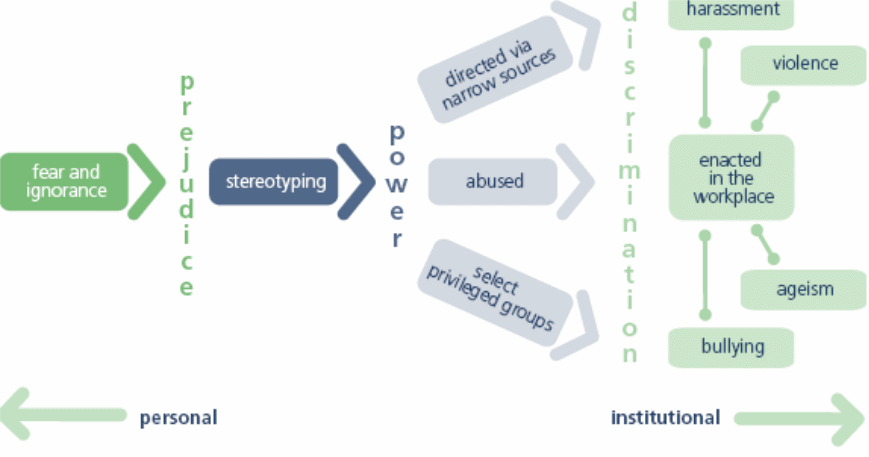
It is important to revisit what the negative way of thinking or ill conducts at workplace could consist of narrow-mindedness, classifying workers, and practicing inequity with them; however, some acts that no firm should practice in case of recruiting, retaining, or terminating workers in today’s world where globalization embraces businesses from all spheres. Furthermore, Kanter (1977) brilliantly identified a very fundamental challenge that firms undertaking action to form a multi-cultural workforce should consider seriously, even though, it is quite surprising, but still, in this era of civilization, communication between workers of different races poses a major challenge for this particular purpose in various ways.
Without any doubt, it is highly crucial for the firms to defeat ideological, traditional, and verbal conversational obstacles rather quickly in order to diversify successfully; otherwise, the entire diversification agenda may fail resulting in loss of money and time; in addition, poor communication amid the co-workers may cause misunderstanding, uncertainty, poor collaboration, as well as poor confidence.
Barak (2010) noted that one of the most alarming truth is that almost all employers in the most famous business organizations have agreed that their respective workforces always possess some workers who decline to acknowledge that the societal or traditional composition of the working environment is shifting; such totally conformist or old-fashioned attitude muzzles innovative thoughts, slowing down advancement.
UNAC and UNGCO (2009) noted that while dealing with cross-cultural concerns within the firm; it is likely to face major obstacles in international-situational context; these obstacles may result due to firm failing to administer diverse working conditions, failing to offer an extensive variety of clients, poorly maintaining intercontinental supply-chains, and wrongly adopting multi-cultural strategies that do not fit with it.
Successful Management of Diversity in the Workplace
CIPD (2010) noted that managing diversity successfully is a great achievement for any business; however, the entire process is quite multifaceted and lengthy and so it is never too easy to succeed in workplace diversification without enough efforts given from the top management of the company. In order to achieve success in this arena, certain methods must be followed; most of the companies that became successful had formulated fresh policies of appointment to get superior outcomes and maintained the perception of appreciating and running multiplicity inside the labor force; certain firms have controlled the dissimilarities to form creative surroundings on which everyone undergo same experiences.
However, the key idea lies behind making a complete use of the intellects of the workers to meet the aims; according to CIPD (2010), the main actions of the businesses that successfully managed diversity were to reformulate corporate missions more powerfully, scrutinize equality and compliance with key objectives regularly, activate flexibility in practices, focus-individually to endorse workers, and empower corporate-culture. The figure below shows several multifaceted affairs attached in workplace adherence, which often cause faulty decision or unsuitable steps taken in the administrative procedure; however, this habitually causes favoritism and deprived administration of diversity; such aspects never stay stagnant and do not transmit identical problems in decision-making process-
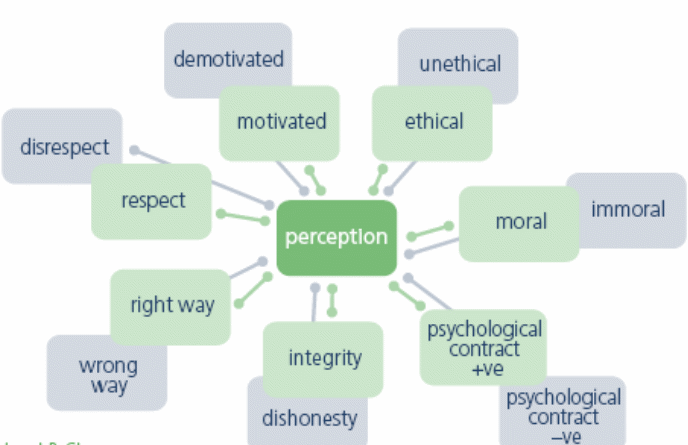
The following chart shows the method by which major companies have achieved success in dealing with an assorted workforce; it shows how individual perceptions, effective communication, mutual respect, consultation, and joint resolution has made the difference-
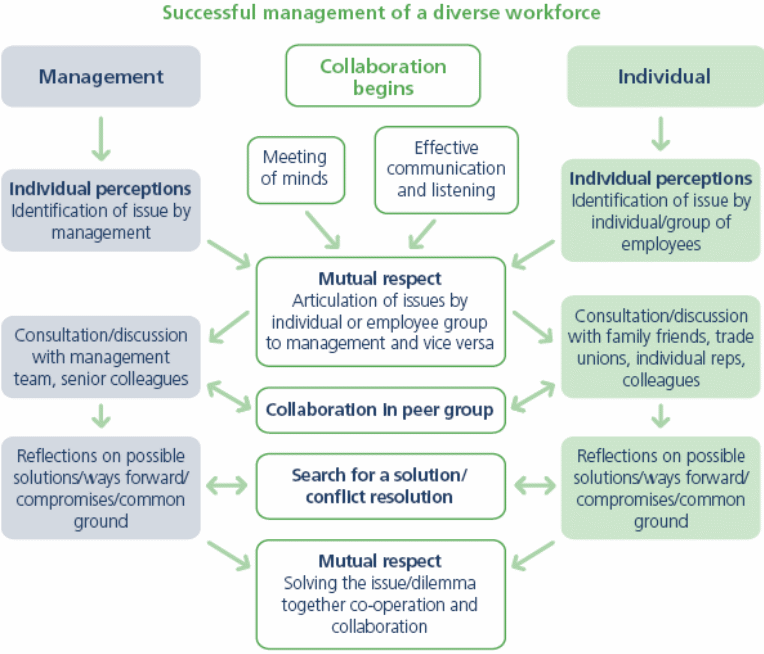
A number of industries, in order to become successful, have reshuffled their respective corporate cultures, and introduced more open-ended, flexible, democratic, and friendly models, as illustrated below-
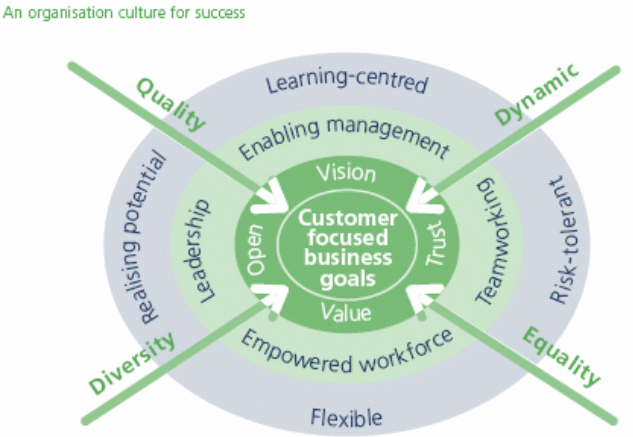
Assessment of Diversity in the Workplace
Bell (2011) stated that assessing diversity of human resources in workplace is a scheme that managers use for appraising workplace efficiency and output; HR-diversity may consist ethnicity, character, country, religious-believe, etc; to bring together the company by connecting all such people, firms use various strategies; however, only some of those firms assesses the extent to which such strategies are performing. A proper assessment of diversity in the workplace may include identifying how well the co-workers are coping up with the changes, whether there is any change of attitude of the managers, whether any kind of bias still exist in the firm, and reassuring that the minorities are feeling friendly.
CIPD (2010) assessed diversity in the workplace in case of employment of people from different ethnic backgrounds; the graph below suggests the extent to which diversity has been increasing in employment rates of people aging from sixteen to seventy-four; the participation of women is also compared in the following figure-
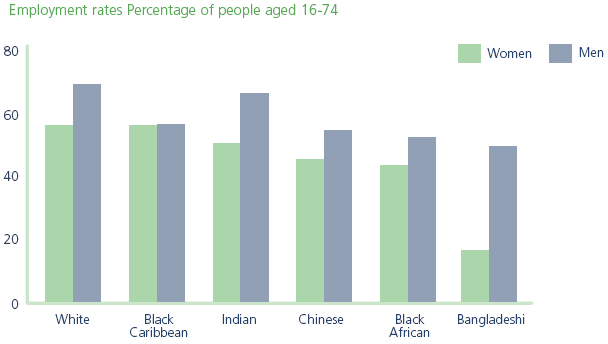
According to the following graph, global organizations are becoming increasingly diverse in terms of assortment of workers; over at least seven industries, the participation of ethnic minorities are considerable; moreover, especially in case of black Africans, Bangladeshis, and Chinese, the participation of female workers has raised remarkably, thus, flourishing cross-cultural diversity –
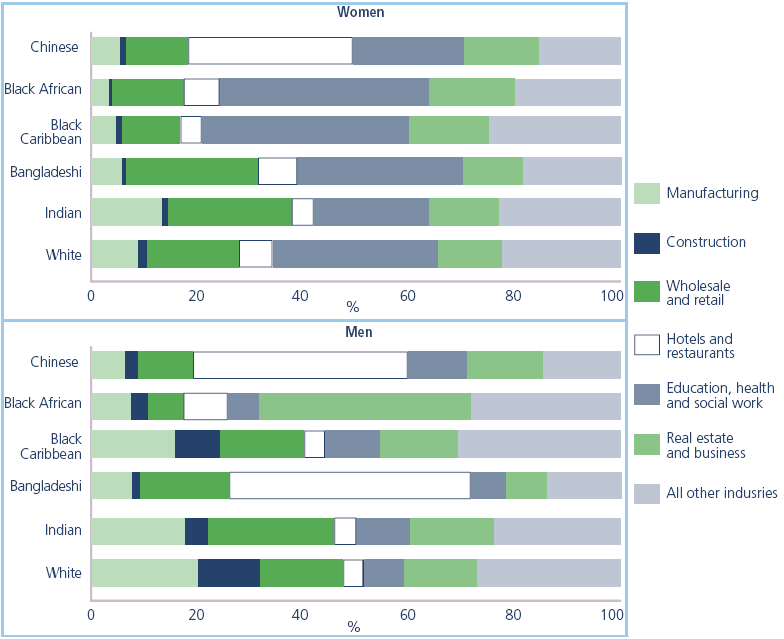
After assessing diversity in certain developing countries, it became clear that the world has changed not only in terms of rapid globalization, but also in terms of social viewpoints. In professional sectors of the UK, there has been a rising number of people from those developing countries, whereas in case of Bangladeshi workers, the percentage of female were higher than that of male-
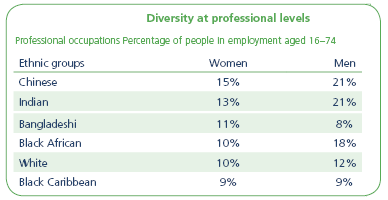
Development and Promotions of Diversity in the Workplace Plan
Marques (2008) stated that developments and promotions of diversities are interrelated concepts; this is because it can be possible to promote diversity in course of developing it through different measures; these measures may include incessant renovation through joint erudition, creating a satisfied client base to ascertain that nobody is being estranged, and making secure labor force with smaller turnover rate. At the same time, UNAC and UNGCO (2009) noted that in order to promote diversity throughout the development process, it would be vital to motivate stakeholders towards adopting an anti-racial attitude and eliminating elitist cultures.
The figure below shows that for developing long lasting diversity in workplace, it is important to promote a comprehensive model rather developing little divisions, to ensure that the firm satisfies mass customers with diverse needs; however, this can be done by identifying potential-clients, and isolating workers to serve them at organizational levels; this strategy, in turn, can promote mutual learning:
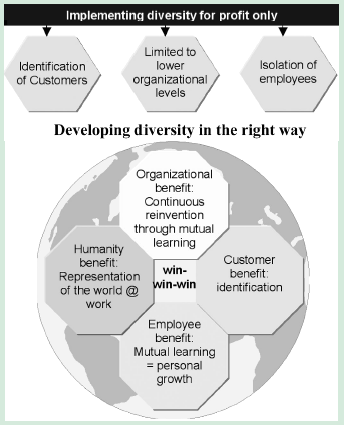
Actualization
Jackson (1993) argued that it is highly significant to actualize diversity; as a result, it is important to promote diversity in firms; this can be done through a number of ways; firstly, it is important to form the firm’s stance concerning diversity and offer a method to calculate improvements and identify main concerns. Surveying worker contentment could give vital information; moreover, the findings could be used for enhancing and amplifying the progress rates; on the other hand, diversity administrators could make the enrollment procedure translucent and notify people regarding the benefits; however, it must not be ignored that creating employee-friendly atmosphere would be the key to promote diversity (Jackson 1993).
On the contrary, giving advantages like on site daycare, infant-care funding, supple agendas, and special pious vacation would help show minority workers some respect, thus promoting diversity; in addition, Hayles and Russell (1997) found that keeping an eye on diversity agendas would be vital to achieve actual success, but it should be done besides of requesting responses. However, among all these, the most essential task would be to respond swiftly and smartly to any latent changes, and adjusting and adapting to the changes without any hesitations for more effective results.
Recommendations
In order to bring diversity in workplace successfully, the businesses must connect apprehensions for diversity with HR administration and evaluation in employment, assortment, posting, progression arrangement, action administration, as well as remuneration patterns; firms must generate an atmosphere where inspiration, contentment, in addition to obligation of the miscellaneous co-workers can be boost from an overall point of view.
In addition, the firms should institute operational benchmarks evidently and impartially, plus efficiently correspond to purposeful measures devoid of whichever prejudice; on the other hand, employers must also recognize smart and objectionable conducts, which should be founded on functional response regarding miscellaneous labor forces that they handle with, in context of the diversification agenda undertaken by the top management.
It is highly important to note that the diversification agendas should be built by the wants and desires of the people working within the business, and in correspondence with the potency and customs of the business; in addition, the decision-makers should recognize the business traditions primarily and after that execute the relevant agendas in correspondence with those factors. In addition, it essential to appreciate the fact that one of the major challenges that the businesses face while implementing diversification agendas is the problem of apt communication between the co-workers; as a result, it is vital to give relevant recommendations for improving communication in diversified workplaces-
Table 2: Key recommendations for improving communication.
At this stage, considering all the issues and challenges that hamper an organization during diversifying the workplace (which has been discussed earlier in this paper), it would be helpful to outline briefly the key recommendations appropriate for the organizations in this century-
Table 3: Assessing the recommendations for diversity in workplaces.
Most importantly, it is essential to recommend the employers that they should realize unfairness and its results; they should realize their individual partiality or chauvinism because assortments are not merely based on dissimilarities between classes, but also on dissimilarities between individuals; definitely, the success would depend on employer’s capacity of comprehending the most suitable strategies for the business.
Conclusion
At this stage of the paper, it is essential to state that diverse workplaces are the manifestation of shifting corporate world, as dissimilar employees convey elevated productivity and creativeness as a whole; moreover, admiring personal dissimilarities would mean variation and change of taste at operational segment assisting the corporation through generation of a feasible circumference and augmenting efficiency and output.
Conversely, efficient-administration of diversity repays people within organizations through making impartial and protected atmosphere to ensure everybody’s participation on risks or disputes; moreover, administrative devices at diverse-workplace must edify everybody regarding assortment concerns, as well as rules and legislation; since majority of workplaces confront these dilemmas presently, they must look forward to discovering ways to cope efficiently for being successful.
However, varieties among employees create disparity at workplace, and encourages proper allotment of limited or precious capitals and capabilities; on the other hand, all these issues result in imitation of unevenness, which conversely influence allotment of decision-making, assessment procedures, and worker accumulation in particular perspectives; so, discrimination, is adversely affected by these approach in terms of composition and psychosomatic outlooks. After assessing numerous issues, it is important to state that for successful outcomes of ensuring and managing diversity in workplace, recruiters must give joint efforts and directly observe the employment or labor legislation for tackling and removing diversity concerns; in fact, the firms must do this before the preamble of the agenda and all through the execution period.
Reference List
Alcazar, F. M., Fernandez, P. M., & Gardey, G. S. (2013). Workforce diversity in strategic human resource management models. Cross Cultural Management, 20(1), 39-49.
Barak, M. E. M. (2010). Managing diversity: Toward a Globally inclusive workplace. New York, the USA: Sage Publications.
Bell, M. P. (2011). Diversity in Organizations. (2nd ed.). Ontario, Canada: Cengage Learning.
CIPD. (2010). Managing diversity: people make the difference at work – but everyone is different. Web.
Hayles, V. R., & Russell, A. M. (1997). The diversity directive. New York, the USA: McGraw-Hill.
Jackson, S. E. (1993). Diversity in the Workplace: Human Resources initiatives. (1st ed.). New York, the USA: The Guilford Press.
Kanter, R. M. (1977). Men and women of the corporation. New York, the USA: Basic Books.
Kundu, S. C. (2003). Workforce diversity status: a study of employees’ reactions. Industrial Management & Data Systems, 103(4), 215-226.
Marques, J. (2008). Workplace diversity: developing a win-win-win strategy. Development and learning in organizations, 22(5), 5-8.
Meyers, J. S. (2006). Workplace democracy comes of age: economic stability, growth, and workforce diversity. Research in the Sociology of Work, 16(1), 205-237.
Skaggs, S., & DiTomaso, N. (2004). Understanding the Effects of Workforce Diversity on Employment Outcomes: A Multidisciplinary and Comprehensive Framework. Research in the Sociology of Work, 14(1), 279-306.
Tisserant, P., Wagner, A. L., & Barth, I. (2013). The propensity to discriminate: a diagnostic indicator for diversity management. Equality, Diversity and Inclusion: An International Journal, 32(1), 36-48.
UNAC & UNGCO. (2009). Doing Business in a Multicultural World: challenges and opportunities. Web.